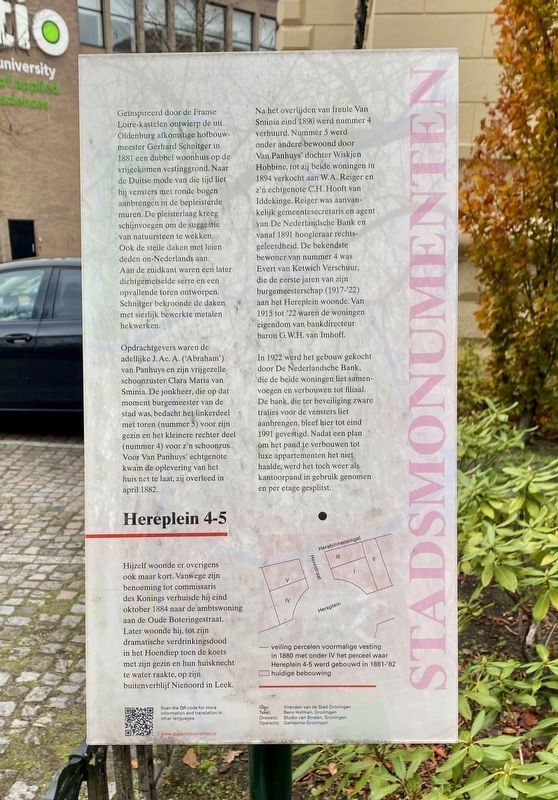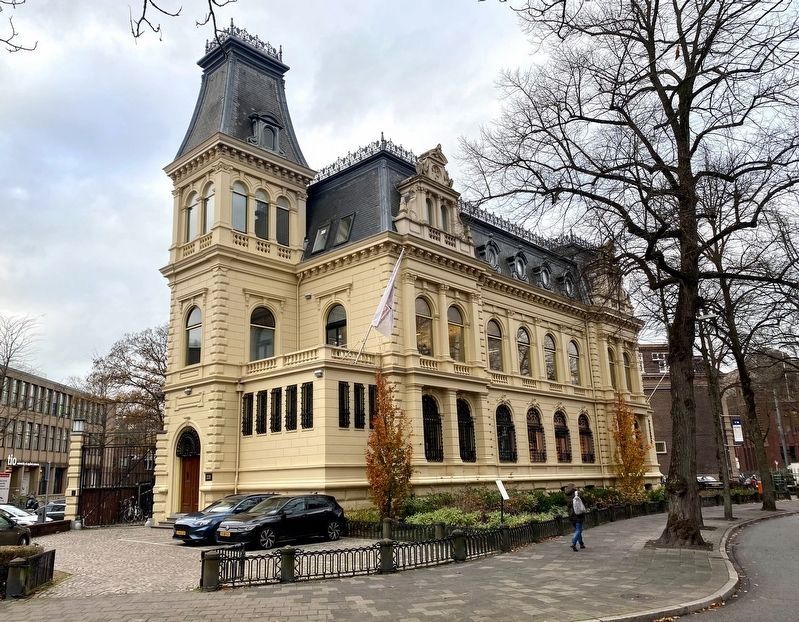Groningen, Netherlands — Northwestern Europe
Hereplein 4-5
— Stadsmonumenten —
Opdrachtgevers waren de adellijke J. Ae. A. (‘Abraham’) van Panhuys en zijn vrijgezelle schoonzuster Clara Maria van Sminia. De jonkheer, die op dat moment burgemeester van de stad was, bedacht het linkerdeel met toren (nummer 5) voor zijn gezin en het kleinere rechter deel (nummer 4) voor z’n schoonzus. Voor Van Panhuys’ echtgenote kwam de oplevering van het huis net te laat, zij overleed in april 1882.
Hijzelf woonde er overigens ook maar kort. Vanwege zijn benoeming tot commissaris des Konings verhuisde hij eind oktober 1884 naar de ambtswoning aan de Oude Boteringestraat. Later woonde hij, tot zijn dramatische verdrinkingsdood in het Hoendiep toen de koets met zijn gezin en hun huisknecht te water raakte, op zijn buitenverblijf Nienoord in Leek.
Na het overlijden van freule Van Sminia eind 1890 werd nummer 4 verhuurd. Nummer 5 werd onder andere bewoond door Van Panhuys’ dochter Wiskjen Hobbine, tot zij beide woningen in 1894 verkocht aan W.A. Reiger en z’n echtgenote C.H. Hooft van Iddekinge. Reiger was aanvankelijk gemeentesecretaris en agent van De Nederlandsche Bank en vanaf 1891 hoogleraar rechtsgeleerdheid. De bekendste bewoner van nummer 4 was Evert van Ketwich Verschuur, die de eerste jaren van zijn burgemeesterschap (1917-’22) aan het Hereplein woonde. Van 1915 tot ’22 waren de woningen eigendom van bankdirecteur baron G.W.H. van Imhoff.
In 1922 werd het gebouw gekocht door De Nederlandsche Bank, die de beide woningen liet samenvoegen en verbouwen tot filiaal. De bank, die ter beveiliging zware tralies voor de vensters liet aanbrengen, bleef hier tot eind 1991 gevestigd. Nadat een plan om het pand te verbouwen tot luxe appartementen het niet haalde, werd het toch weer als kantoorpand in gebruik genomen en per etage gesplitst.
In 1881, inspired by the French Loire castles, the court architect Gerhard Schnitger from Oldenburg designed
a double house on the vacant fortress ground. In accordance with the German fashion of the time, he had windows with round arches installed in the plastered walls. The plaster layer was given false joints to create the impression of natural stone. The steep roofs with slates also looked un-Dutch. On the south side, a later bricked-up conservatory and a striking tower were designed. Schnitger topped off the roofs with ornately crafted metalworks.
Clients were the noble J. Ae. A. ('Abraham') van Panhuys and his unmarried sister-in-law Clara Maria van Sminia. The esquire, who was mayor of the city at the time, devised the left part with tower (number 5) for his family and the smaller right part (number 4) for his sister-in-law. For Van Panhuys' wife, the completion of the house came just too late, as she died in April 1882.
He himself only lived there for a short time. Because of his appointment as the King's Commissioner, he moved to the official residence on Oude Boteringestraat at the end of October 1884. Later, until his dramatic death by drowning in the Hoendiep when his carriage ran into the water with his family and their house servant, he lived at his country residence Nienoord in Leek. After the death of Lady Van Sminia at the end of 1890, number 4 was rented out. Number 5 was, among others, occupied by Van Panhuys' daughter Wiskjen Hobbine, until she sold both houses in 1894 to W.A. Reiger and his wife C.H. Hooft van Iddekinge. Reiger was initially municipal secretary and agent of De Nederlandsche Bank and from 1891 professor of law. The most famous resident of number 4 was Evert van Ketwich Verschuur, who lived here on Hereplein during the first years of his mayorship (1917-'22). From 1915 to 1922 the houses were owned by bank manager Baron G.W.H. van Imhoff.
In 1922 the building was bought by De Nederlandsche Bank, which had the two houses merged and converted into a branch. The bank, which had heavy bars installed on the windows for security, remained here until the end of 1991. After a plan to convert the building into luxury apartments failed, it was again used as an office building and split by floor.
Erected by Gemeente Groningen. (Marker Number 99.)
Topics and series. This historical marker is listed in these topic lists: Architecture • Industry & Commerce. In addition, it is included in the Groningen Stadsmonumenten series list.
Location. 53° 12.804′ N, 6° 34.136′ E. Marker is in Groningen. Marker is on Hereplein, on the right when traveling south. Touch for map. Marker is at or near this postal address: Hereplein 4-5, Groningen 9711 BA, Netherlands. Touch for directions.
Other nearby markers. At least 8 other markers are within walking distance of this marker. Herestraat 106 (about 90 meters away, measured in a direct line); De Toekomst / “The Future” (about 180 meters away); Heresingel 13 (about 210 meters away); Ged. Zuiderdiep 96-98 (approx. 0.3 kilometers away); Synagogue (approx. 0.3 kilometers away); St. Jozefkerk / St. Joseph Church (approx. 0.3 kilometers away); Tuinkoepel Scholten (approx. 0.4 kilometers away); Hoofdstation / Main Railway Station (approx. 0.4 kilometers away). Touch for a list and map of all markers in Groningen.
Credits. This page was last revised on December 31, 2023. It was originally submitted on November 26, 2022, by Andrew Ruppenstein of Lamorinda, California. This page has been viewed 91 times since then and 19 times this year. Photos: 1, 2. submitted on November 26, 2022, by Andrew Ruppenstein of Lamorinda, California.

